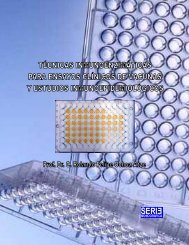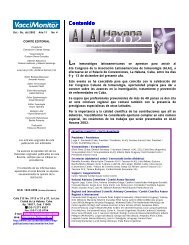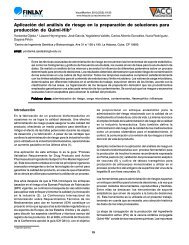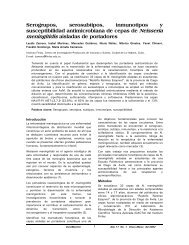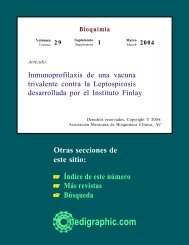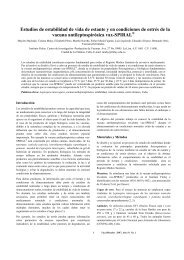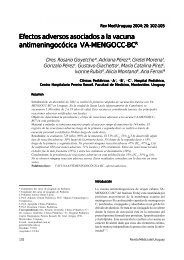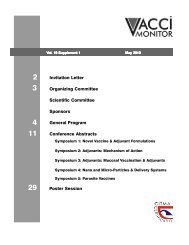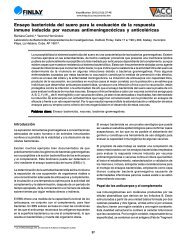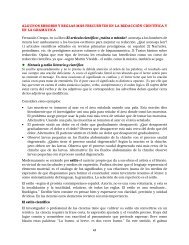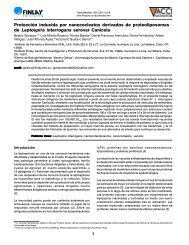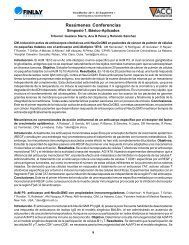Mycobacterium tuberculosis: factores de virulencia - Instituto Finlay
Mycobacterium tuberculosis: factores de virulencia - Instituto Finlay
Mycobacterium tuberculosis: factores de virulencia - Instituto Finlay
Create successful ePaper yourself
Turn your PDF publications into a flip-book with our unique Google optimized e-Paper software.
comparison with human monocyte<strong>de</strong>rived macrophages. Cell<br />
Immunol 1999;197:1-9.<br />
22. Wilson TM, <strong>de</strong> Lisle GW, and Collins DM. Effect of inhA and<br />
katG on isoniazid resistance and virulence of <strong>Mycobacterium</strong><br />
bovis. Mol Microb 1995;15:1009-15.<br />
23. Mariani F. <strong>Mycobacterium</strong> <strong>tuberculosis</strong> H37Rv comparative<br />
gene-expression analysis in synthetic medium and human<br />
macrophage. Gene 2000;253(2):281-91.<br />
24. McCarthy TR, Torrelles J B, MacFarlane ASh, Katawczik M,<br />
Kutzbach B, DesJardin LE, et. al. Overexpression of<br />
<strong>Mycobacterium</strong> <strong>tuberculosis</strong> manB, a phosphomannomutase<br />
that increases phosphatidylinositol mannosi<strong>de</strong> biosynthesis<br />
in <strong>Mycobacterium</strong> smegmatis and mycobacterial association<br />
with human macrophages. Molecular Microbiology<br />
2005;58:774-90.<br />
25. Muttucumaru DG N and Parish T. The Molecular Biology of<br />
Recombination in Mycobacteria: What Do We Know and How<br />
Can We Use It? Curr Issues Mol Biol 2004;6:145-58.<br />
26. Gey Van Pittius NC, Gamieldien J, Hi<strong>de</strong> W, Brown G D, Siezen<br />
RJ, and Beyers A D. The ESAT-6 gene cluster of <strong>Mycobacterium</strong><br />
<strong>tuberculosis</strong> and other high G+C gram-positive bacteria.<br />
Genome Biol 2001;2(10): Research 0044.1-18.<br />
27. Wang R, Prince JT and Marcotte EM. Mass spectrometry of the<br />
Protein M. smegmatis proteome: expression levels correlate<br />
with function, operons, and codon bias. Genome Res<br />
2005;15:1118-26.<br />
28. Álvarez N, Borrero R, Reyes F, Camacho F, Mohd N, Sarmiento<br />
M, Acosta A. Mecanismos <strong>de</strong> evasión y persistencia <strong>de</strong><br />
<strong>Mycobacterium</strong> <strong>tuberculosis</strong> durante el estado <strong>de</strong> latencia y<br />
Borrero R, et al. VacciMonitor 2011;20(1):34-38<br />
<strong>Mycobacterium</strong> <strong>tuberculosis</strong>: virulence factors<br />
Abstract Abstract<br />
Abstract<br />
38<br />
posibles estrategias para el control <strong>de</strong> la infección latente.<br />
Vaccimonitor 2009;18 (3):18-25.<br />
29. Brosch R, SV Gordon, M Marmiesse, P Brodin, C Buchrieser, K<br />
Eiglmeier, et al. A new evolutionary scenario for the<br />
<strong>Mycobacterium</strong> <strong>tuberculosis</strong>. Proc Natl Acad Sci USA<br />
2002;99:3684-9.<br />
30. Pai RK, Pennini M, Tobian AA, Canaday DH, Boom WH, Harding<br />
CV. Prolonged Toll-like Receptor signaling by <strong>Mycobacterium</strong><br />
<strong>tuberculosis</strong> and its 19-kDa lipoprotein inhibits Interferon-ginduced<br />
regulation of selected genes in macrophages. Infect<br />
Immun 2004; 72:6603-14.<br />
31. Raynaud C, Papavinasasundaram KG, Speeght RA, Springer<br />
B, San<strong>de</strong>r P, Bottger EC, et. al. The functions of OmpATb, a<br />
pore-forming protein of <strong>Mycobacterium</strong> <strong>tuberculosis</strong>. Mol<br />
Microbiol 2002;46:191-201.<br />
32. Vergne I, Fratti RA, Hill PJ, Chea J, Belisle J and Deretic V.<br />
<strong>Mycobacterium</strong> <strong>tuberculosis</strong> phagosome maduration arrest:<br />
mycobacterial phosphatidylinositol analog<br />
phosphatidylinositol mannosi<strong>de</strong> stimulates early endosomal<br />
fusion. Mol Biol Cell 2004;15:751-60.<br />
33. Sambandamurthy V K and Jacobs W R. Live attenuated mutants<br />
of<strong>Mycobacterium</strong> <strong>tuberculosis</strong> as candidate vaccines against<br />
<strong>tuberculosis</strong>.Microbes and Infection 2005;7:955-61.<br />
34. Gonzalo-Asensio J, Mostowy S, Har<strong>de</strong>rs-Westerveen J, Huygen<br />
K, Hernán<strong>de</strong>z-Pando R, Thole J, et al. PhoP: A Missing Piece in<br />
the Intricate Puzzle of <strong>Mycobacterium</strong> <strong>tuberculosis</strong> Virulence.<br />
PLoS ONE 2008;3(10). e3496.doi:10.1371/journal.pone.0003496<br />
<strong>Mycobacterium</strong> <strong>tuberculosis</strong> is the causative agent of <strong>tuberculosis</strong>, one of the most lethal diseases worldwi<strong>de</strong>.<br />
BCG is the only available vaccine for <strong>tuberculosis</strong> control, but at the same time it fails in the protection from<br />
pulmonary <strong>tuberculosis</strong>, which is the most common and responsible form of dissemination. The i<strong>de</strong>ntification of<br />
virulence factors of the causative organism could help in <strong>de</strong>veloping a new vaccine candidate capable of neutralizing<br />
the action of these pathogenic <strong>de</strong>terminants. The use of different animal mo<strong>de</strong>ls has allowed to reproduce the<br />
stages of the disease and to measure or to quantify the virulence of different circulating strains of M. <strong>tuberculosis</strong>.<br />
Gene mutations and other molecular biology techniques have ma<strong>de</strong> possible to elucidate the specific genes<br />
involved in virulence of this organism, that enco<strong>de</strong>s many complex and different factors.<br />
Keywords Keywords: Keywords <strong>Mycobacterium</strong> <strong>tuberculosis</strong>, virulence factors, genes.<br />
Recibido: Marzo <strong>de</strong> 2010 Aceptado: Mayo <strong>de</strong> 2010




